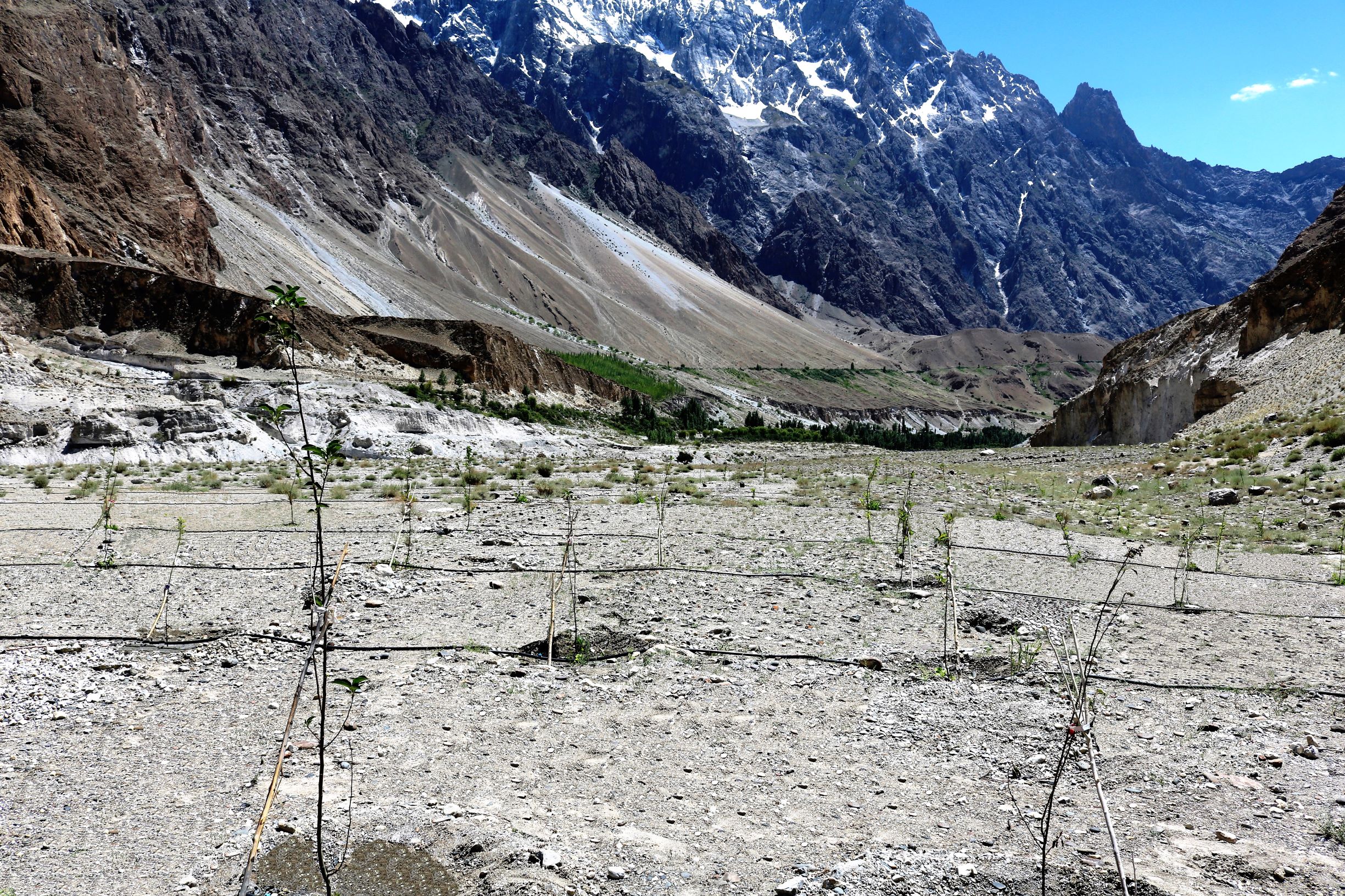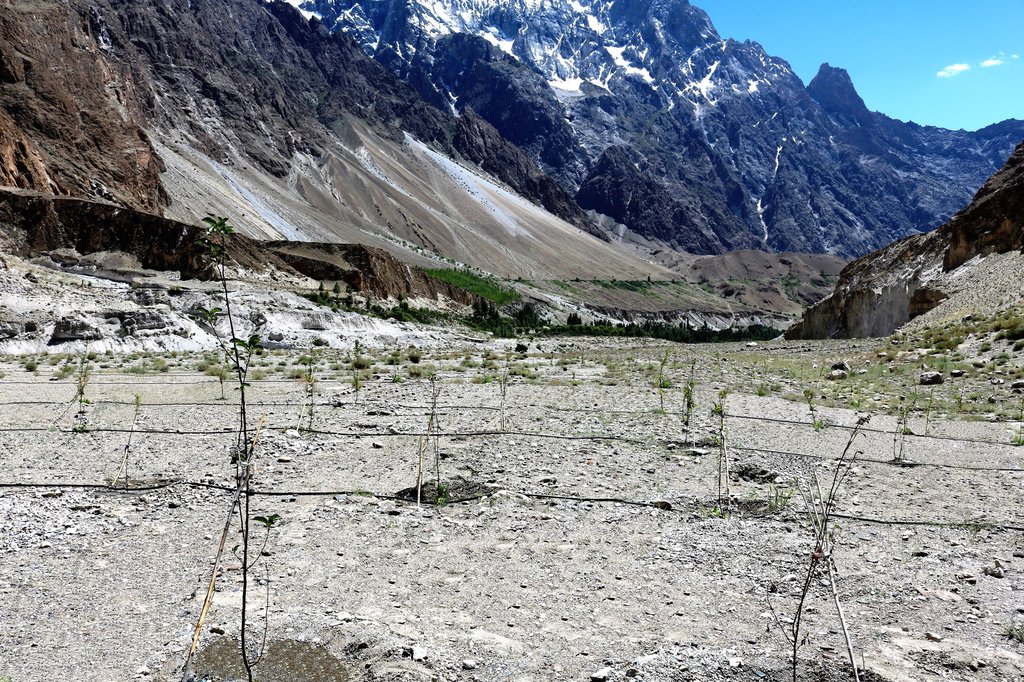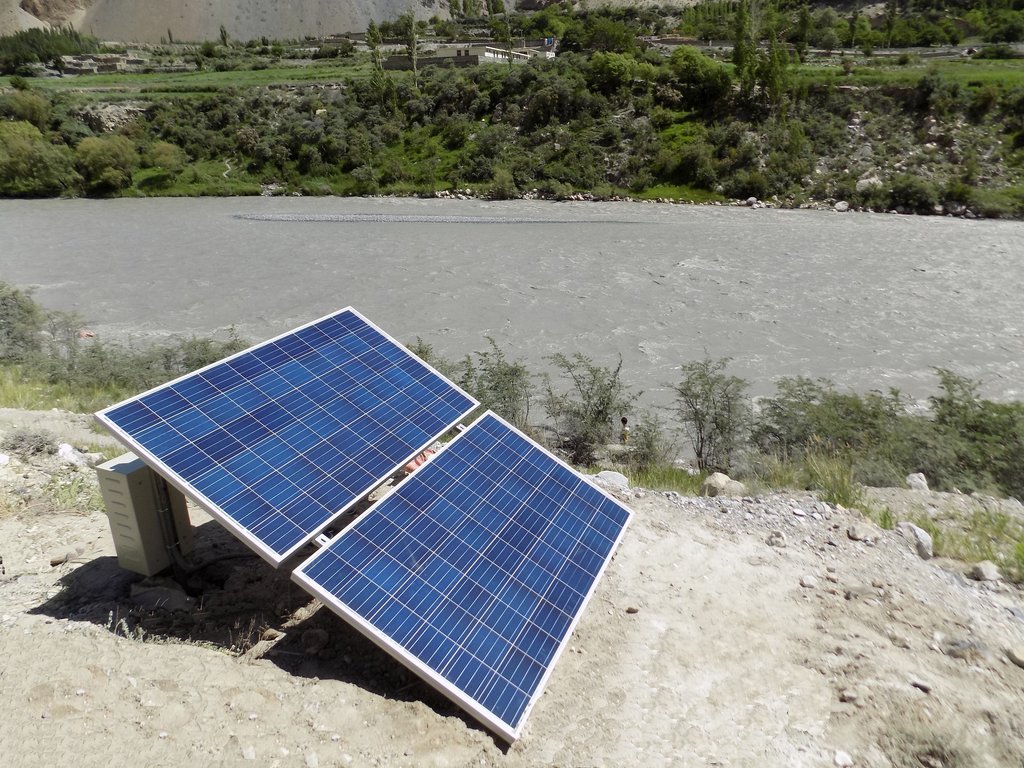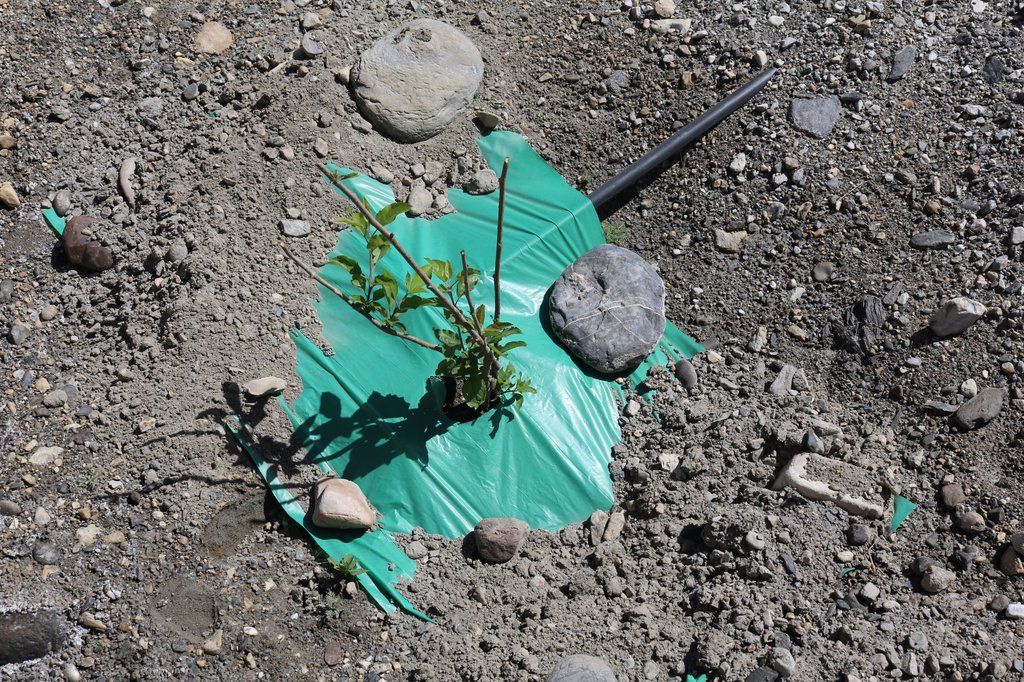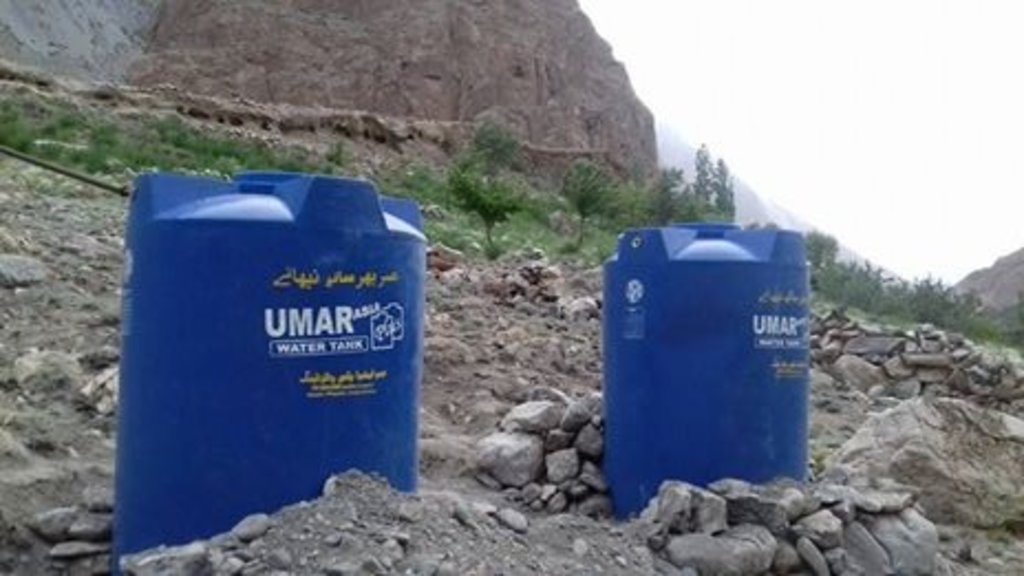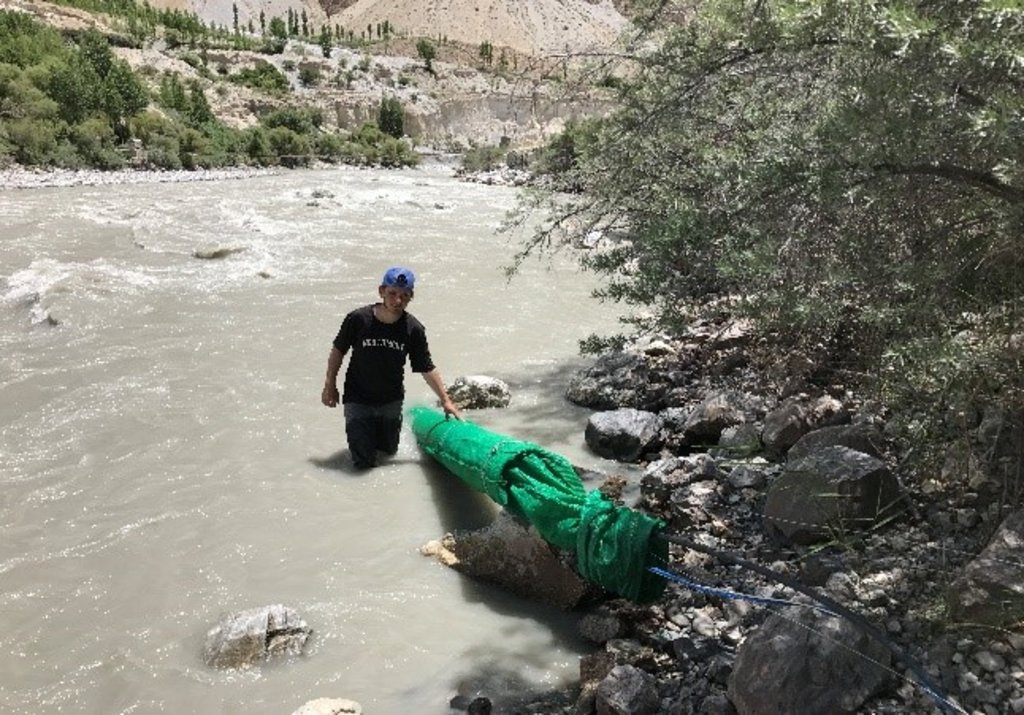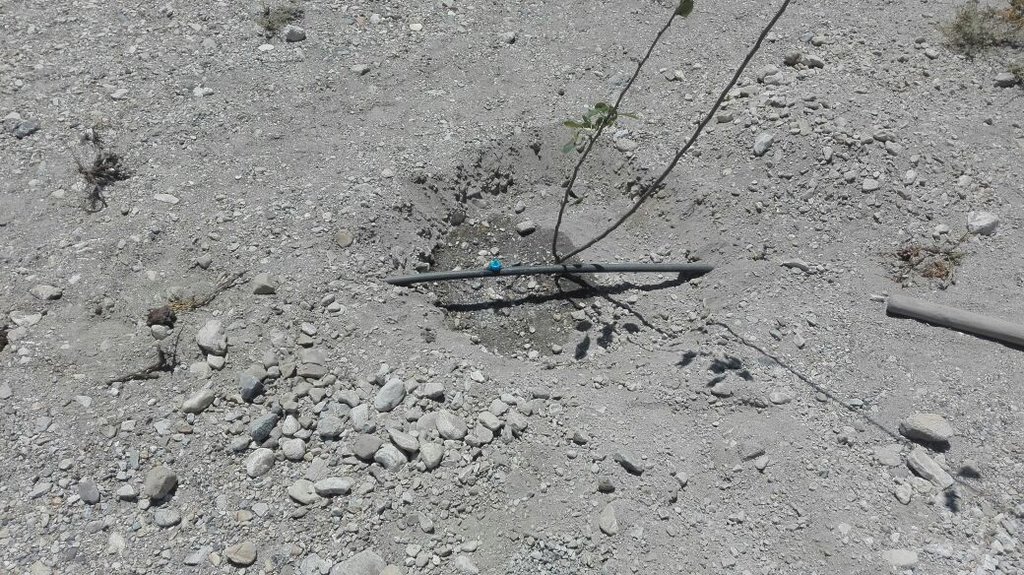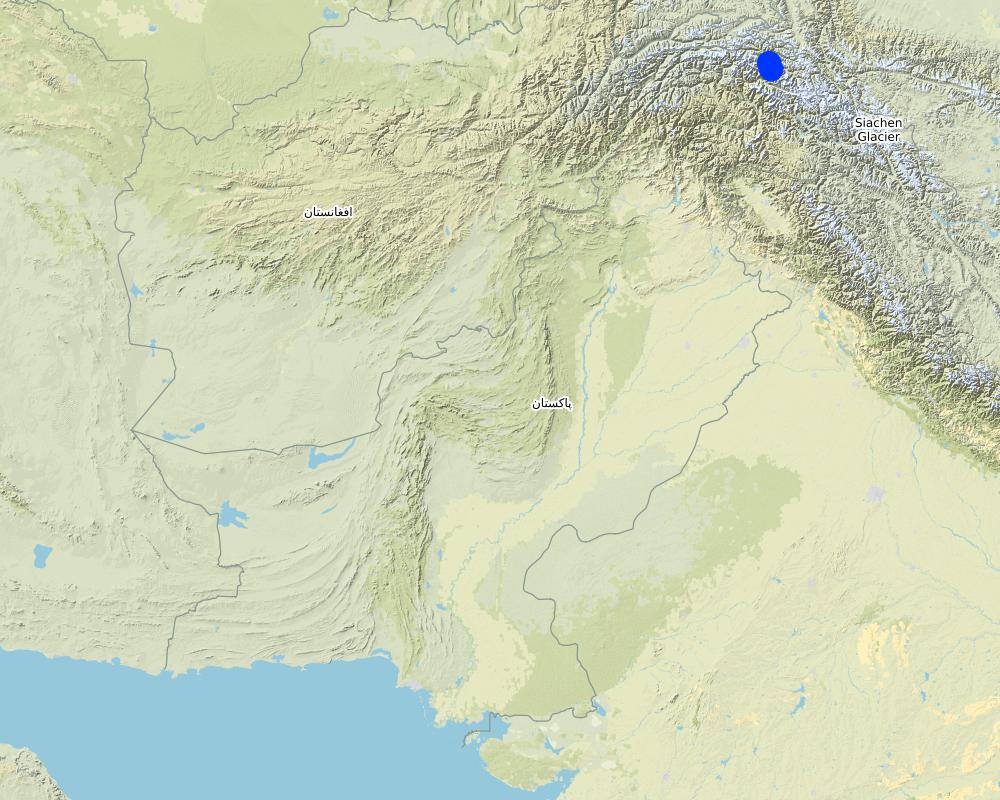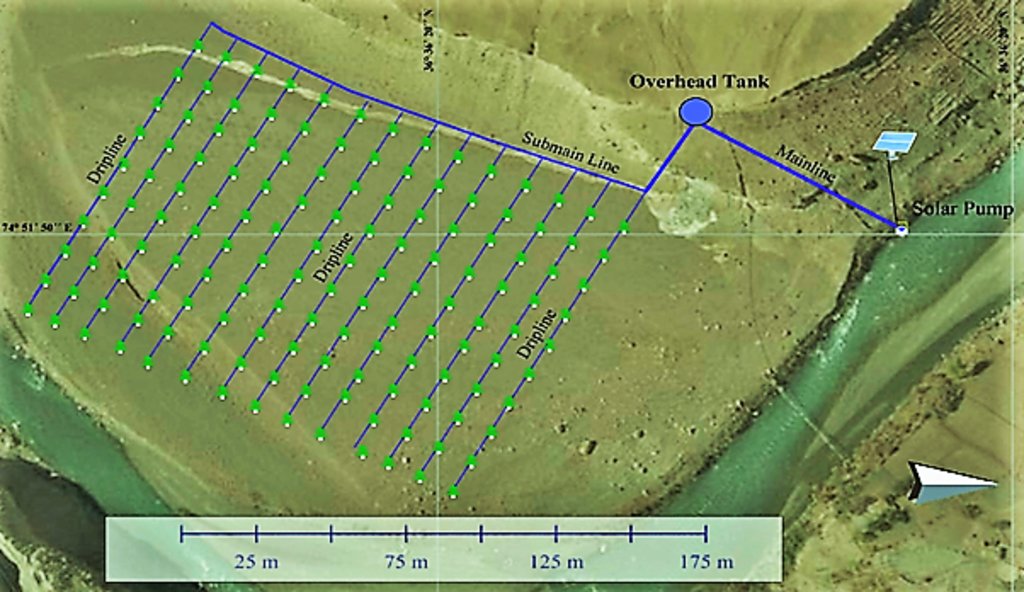Solar Power Water Lifting and Application to Orchard through Drip Irrigation [Pakistan]
- Création :
- Mise à jour :
- Compilateur : Madhav Dhakal
- Rédacteur : –
- Examinateur : Rima Mekdaschi Studer
technologies_5610 - Pakistan
Voir les sections
Développer tout Réduire tout1. Informations générales
1.2 Coordonnées des personnes-ressources et des institutions impliquées dans l'évaluation et la documentation de la Technologie
Personne(s)-ressource(s) clé(s)
Spécialiste GDT:
Maqsood Muhammad Mudassar
International Centre for Integrated Mountain Development
Pakistan
Spécialiste GDT:
Shah Ghulam Muhammad
International Centre for Integrated Mountain Development
Pakistan
Spécialiste GDT:
Bhatti Ahmad Zeeshan
Pakistan Council of Research in Water Resources
Pakistan
Spécialiste GDT:
Khan Muhammad Zafar
Karakorum International University
Pakistan
Spécialiste GDT:
Khan Babar
World Wide Fund For Nature
Pakistan
Spécialiste GDT:
Ali Rehmat
World Wide Fund For Nature
Pakistan
Spécialiste GDT:
Ali Amjad
Karakorum International University
Pakistan
Spécialiste GDT:
Ali Ajaz
International Centre for Integrated Mountain Development
Pakistan
Spécialiste GDT:
Dhakal Madhav
International Centre for Integrated Mountain Development
Népal
Nom du projet qui a facilité la documentation/ l'évaluation de la Technologie (si pertinent)
Agricultural Water, Energy, and Hazard Management for Improved Livelihood in the Upper Indus Basin, Pakistan (UIB, Pakistan)Nom du ou des institutions qui ont facilité la documentation/ l'évaluation de la Technologie (si pertinent)
ICIMOD International Centre for Integrated Mountain Development (ICIMOD) - Népal1.3 Conditions relatives à l'utilisation par WOCAT des données documentées
Le compilateur et la(les) personne(s) ressource(s) acceptent les conditions relatives à l'utilisation par WOCAT des données documentées:
Oui
1.4 Déclaration sur la durabilité de la Technologie décrite
Est-ce que la Technologie décrite ici pose problème par rapport à la dégradation des terres, de telle sorte qu'elle ne peut pas être déclarée comme étant une technologie de gestion durable des terres?
Non
2. Description de la Technologie de GDT
2.1 Courte description de la Technologie
Définition de la Technologie:
Water from the Hunza river was lifted through solar powered pump, stored above ground plastic tanks and applied to newly planted apple orchards through efficient drip irrigation. Mulch was applied to the plants to conserve soil moisture.
2.2 Description détaillée de la Technologie
Description:
The fragile rouged mountains prone to the effect of climate change makes the mountain com-munities in Gilgit-Baltistan of Pakistan more vulnerable. Agriculture is the major source of their livelihoods and it purely dependents on glacier meltwater which makes the community more susceptible due to the unstable behaviour of the glaciers. Irrigation is practised with traditional irrigation canals, intake of which is located at glacier terminus. On one hand lowering of glacier surface disconnects many irrigation canals. Uncertain glacier behaviour has resulted in the decline of water availability and even forced some communities to abandon their agricultural land. On the other hand, only 2% of land in Gilgit-Baltistan is used for agriculture purposes whereas a huge chunk of barren land lays above the Hunza River, which cannot be cultivated through the traditional irrigation system hence it remains unutilized.
To address both issues, ICIMOD together with a local level partner’s consortia piloted solar water lifting to irrigate barren land for establishing apple orchards along Hunza River at Passu and Morkhun Villages. These two villages are located far from each other. In each village, orchards of 2.5 hectare area were established and the drip irrigation system installed was efficiently used to irrigate apple plants. Similar technological packages (solar pump, drip irrigation and mulch) were applied in both the villages.
The pumping system comprises a submersible pump (Lorentz, Germany 1 HP) powered by 500 watts solar panels to carry the water to storage tanks (500 litres) made up of plastic that has been placed upslope at 100 feet vertical height from the river. The water from the storage tanks was routed/led to the apple saplings through the surface and pressure compensating drip irrigation system. The pumping capacity of the pump is 7.5 litres/minute, which is irrigating around 3300 apple plants at Passu and Morkhun. The storage tank was kept 60 feet vertical height from the orchard field to be irrigated. Tree to tree distance and row to row distance of apple was maintained at 15 feet in Passu and 10 feet in Morkhun. Drip irrigation (surface and pressure compensating) system was established to irrigate each apple plant, the emitter of the drip system was adjusted according to the plant to plant distance of apple seedlings to be irrigated. Pits were constructed for planting apples and later they also served as water harvesting pits /check basins. Plastic mulch was applied to each apple plants covering a radius around the trunk to minimize soil moisture losses, reduce weed and reduce soil erosion by water and wind.
The cost of an integrated package including solar pumps with accessories, storage tanks, intake and distribution systems (i.e. from river to tank and tank to trees), drip irrigation, apple plants and operational expenses (manpower) for both the sites was US$ 42000 for 5 ha of land. Village Development Organizations (VDO) of both villages take care of maintenance of technological package through a maintenance fund, which is being raised by participating households (HHs). Benefit sharing mechanism has been agreed among the participating HHs. The total income would be divided equally among participating 72 HHs in Morkhun and 135 HHs in Passu.
The technological package was applied in arid climate at an elevation ranging from 2340m to 4877 m above sea level. Passu is located at 36.49o latitude and 74.90o longitude and Morkhun is located at 36.6o N latitudes and 74.86o E longitudes. The area receives 150-200 mm annual rain-fall. The temperature ranges from 11 degree Celsius to 29 degree Celsius. The population of Passu and Morkhun is 1168 and 653 persons respectively. Both villages are semi nomadic and depend mainly on livestock rearing.
2.3 Photos de la Technologie
2.4 Vidéos de la Technologie
Date:
09/10/2018
Lieu:
Morkhun and Passu
2.5 Pays/ région/ lieux où la Technologie a été appliquée et qui sont couverts par cette évaluation
Pays:
Pakistan
Région/ Etat/ Province:
Gilgit Baltistan Province
Autres spécifications du lieu:
Morkhun and Passu
Spécifiez la diffusion de la Technologie:
- appliquée en des points spécifiques ou concentrée sur une petite surface
Est-ce que les sites dans lesquels la Technologie est appliquée sont situés dans des zones protégées en permanence?
Non
Map
×2.6 Date de mise en œuvre de la Technologie
Indiquez l'année de mise en œuvre:
2016
Si l'année précise est inconnue, indiquez la date approximative: :
- il y a moins de 10 ans (récemment)
2.7 Introduction de la Technologie
Spécifiez comment la Technologie a été introduite: :
- par le biais de projets/ d'interventions extérieures
Commentaires (type de projet, etc.) :
This package of practices was jointly implemented by Pakistan Council of Research in Water Resources (PCRWR), Worldwide Fund for Nature (WWF) - Pakistan, and ICIMOD
3. Classification de la Technologie de GDT
3.1 Principal(aux) objectif(s) de la Technologie
- améliorer la production
- réduire, prévenir, restaurer les terres dégradées
- s'adapter au changement et aux extrêmes climatiques et à leurs impacts
- créer un impact économique positif
- créer un impact social positif
3.2 Type(s) actuel(s) d'utilisation des terres, là où la Technologie est appliquée
Les divers types d'utilisation des terres au sein du même unité de terrain: :
Non

Terres cultivées
- Plantations d’arbres ou de buissons
- Apple
Nombre de période de croissance par an: :
- 1
Précisez:
April to October, rest months the region is covered with snow
Est-ce que les cultures intercalaires sont pratiquées?
Non
Est-ce que la rotation des cultures est appliquée?
Non
3.3 Est-ce que l’utilisation des terres a changé en raison de la mise en œuvre de la Technologie ?
Est-ce que l’utilisation des terres a changé en raison de la mise en œuvre de la Technologie ?
- Oui (Veuillez remplir les questions ci-après au regard de l’utilisation des terres avant la mise en œuvre de la Technologie)
Les divers types d'utilisation des terres au sein du même unité de terrain: :
Non

Terres cultivées
- Unproductive
Est-ce que les cultures intercalaires sont pratiquées?
Non
Est-ce que la rotation des cultures est appliquée?
Non
3.4 Approvisionnement en eau
Approvisionnement en eau des terres sur lesquelles est appliquée la Technologie:
- pleine irrigation
Commentaires:
Water supply with solar pump and distribution to apple with drip irrigation
3.5 Groupe de GDT auquel appartient la Technologie
- gestion de l'irrigation (incl. l'approvisionnement en eau, le drainage)
- gestion des eaux de surface (sources, rivières, lacs, mers)
- technologies d'efficacité énergétique
3.6 Mesures de GDT constituant la Technologie

pratiques végétales
- V1: Couverture d’arbres et d’arbustes

modes de gestion
- M1: Changement du type d’utilisation des terres
3.7 Principaux types de dégradation des terres traités par la Technologie

érosion hydrique des sols
- Wt: perte de la couche superficielle des sols (couche arable)/ érosion de surface

érosion éolienne des sols
- Et: perte de la couche superficielle des sols (couche arable)

dégradation hydrique
- Ha: aridification

autre
Précisez:
Damage and dysfunction of irrigation canal .
Commentaires:
Damage and dysfunction of irrigation canal intake by shifting nature of glacier as intakes are located at the glacier terminus.
3.8 Prévention, réduction de la dégradation ou réhabilitation des terres dégradées
Spécifiez l'objectif de la Technologie au regard de la dégradation des terres:
- restaurer/ réhabiliter des terres sévèrement dégradées
Commentaires:
due to water access cultivation was possible and vegetation cover improved.
4. Spécifications techniques, activités, intrants et coûts de mise en œuvre
4.1 Dessin technique de la Technologie
Spécifications techniques (associées au dessin technique):
Solar Pump: DC submersible (Lorentz, Germany 1 HP), the capacity of Panels: 500 watts, and pumping capacity of the pump: 7.5 litres/minute.
The capacity of storage tank: 500 litres, location of storage tank: 100 feet height (vertical) from the river and 60 feet height (vertical) from the orchard field.
Drip Irrigation: Surface and pressure compensating. The spacing of dripping points: 10 feet in Morkhun and 15 feet in Passu. Water application per plant by drip irrigation is 2 litres per day.
Plant to plant and row to row distance of apple 10 feet in Morkhun and 15 feet ( both plant to plant and row to row) in Passu coinciding with the dripping holes.
Pits: Constructed for planting apples, later they served as water harvesting pits /check basins.
Plastic mulch: In each plant. Shape of the plastic mulch is rectangular and dimension is variable, average about 5 ft long and 3 feet wide. It is an opaque plastic sheet.
Auteur:
Muhammad Mudassar Maqsood)
Date:
09/10/2018
4.2 Informations générales sur le calcul des intrants et des coûts
Spécifiez la manière dont les coûts et les intrants ont été calculés:
- par entité de la Technologie
Précisez l'unité:
Technological package at two sites ( solar system, water storage tank, drip, orchard establishment, and mulch) , same package is applied in two sites separately. Total area of two sites is 5 ha
Indiquez la monnaie utilisée pour le calcul des coûts:
- dollars américains
Indiquez le coût salarial moyen de la main d'œuvre par jour:
US$ 14.5 for skilled person and US$ 7.5 for unskilled person
4.3 Activités de mise en place/ d'établissement
| Activité | Calendrier des activités (saisonnier) | |
|---|---|---|
| 1. | Site identification in consultation with the communities | Pre Monsson (March) |
| 2. | Detailed engineering surveys, design formulation, tendering and work orders etc | Pre Monsson (March ) |
| 3. | Implementation agreement with the community | Pre Monsson (March) |
| 4. | Installation of solar-powered pumping units with four poly-crystalline solar panels. | Pre Monsson (April) |
| 5. | Installation of storage (plastic tank) with a line filter attached to it for the operation of the drip system and avoid sediment entry into the tank | Pre Monsson (April) |
| 6. | Digging of pits for plantation of the apple orchard at the plant to plant and row distance of 10 feet (Morkhun) and 15 feet (Passu)) | Pre Monsson (April) |
| 7. | Constructed pits for each plant used for application of compost | Pre Monsson (April) |
| 8. | Laying of drip irrigation systems | Pre Monsson (May) |
| 9. | Laying down plastic mulch | Pre Monsson (May) |
| 10. | Plantation of tubed apple (Kala Kolu variety) it is bought from the local nursery | Pre Monsson (May) |
| 11. | Training to selected farmers as caretakers of the technologies for its days to day repair and maintenance | Pre Monsson ( May) |
4.4 Coûts et intrants nécessaires à la mise en place
| Spécifiez les intrants | Unité | Quantité | Coûts par unité | Coût total par intrant | % des coût supporté par les exploitants des terres | |
|---|---|---|---|---|---|---|
| Main d'œuvre | Skilled | Person days | 136,0 | 14,43 | 1962,48 | |
| Main d'œuvre | Unskilled | Person days | 745,0 | 7,7 | 5736,5 | |
| Equipements | Spade | Number | 20,0 | 0,0 | 0,0 | 100,0 |
| Equipements | Shovel | Number | 20,0 | 0,0 | 0,0 | 100,0 |
| Equipements | Plumbing tool kit | Kit box | 1,0 | 0,0 | 0,0 | 100,0 |
| Matériel végétal | Apple Plants | Number | 3300,0 | 0,087 | 287,1 | |
| Matériaux de construction | Solar panel, pump with all accessories | sites | 2,0 | 6490,0 | 12980,0 | |
| Matériaux de construction | Water storage, intake, distribution pipes and mulch | sites | 2,0 | 6861,0 | 13722,0 | |
| Matériaux de construction | Drip irrigation | sites | 2,0 | 4173,0 | 8346,0 | |
| Matériaux de construction | -Check basin (pits) | number | 3300,0 | 0,466 | 1537,8 | |
| Coût total de mise en place de la Technologie | 44571,88 | |||||
| Coût total de mise en place de la Technologie en dollars américains (USD) | 44571,88 | |||||
Si le coût n'est pas pris en charge à 100% par l'exploitant des terres, indiquez qui a financé le coût restant:
The technological package was designed and implemented by ICIMOD's Indus Basin Initiative with partners and contributes to the sustainable Development Investment Portfolio and is supported by the Australian Aid program.
Commentaires:
Establishment costs and inputs for a solar pump –drip irrigation - mulch system was estimated for apple orchards piloted on a 5 hectares of total land in two villages.
4.5 Activités d'entretien/ récurrentes
| Activité | Calendrier/ fréquence | |
|---|---|---|
| 1. | Monitoring of water pumping, storage, and drip system by a regular visit to the site. | Regular (annually) |
| 2. | Repair and maintenance of solar pump panel and drip irrigation: fixing clogged drip lines and replacement of broken solar panel and cleaning of impellers of the solar pump. | Regular (annually) |
| 3. | Replacement of dead apple plants | As and when required |
4.6 Coûts et intrants nécessaires aux activités d'entretien/ récurrentes (par an)
| Spécifiez les intrants | Unité | Quantité | Coûts par unité | Coût total par intrant | % des coût supporté par les exploitants des terres | |
|---|---|---|---|---|---|---|
| Main d'œuvre | Unskilled | Number | 26,0 | 7,7 | 200,2 | |
| Equipements | Spade | Number | 10,0 | 0,0 | 0,0 | 100,0 |
| Equipements | Plumbing tool kit | Kit box | 1,0 | 0,0 | 0,0 | 100,0 |
| Matériel végétal | Apple ( replacement of dead plants) | number | 330,0 | 0,087 | 28,71 | |
| Coût total d'entretien de la Technologie | 228,91 | |||||
| Coût total d'entretien de la Technologie en dollars américains (USD) | 228,91 | |||||
4.7 Facteurs les plus importants affectant les coûts
Décrivez les facteurs les plus importants affectant les coûts :
Equipment and labor
5. Environnement naturel et humain
5.1 Climat
Précipitations annuelles
- < 250 mm
- 251-500 mm
- 501-750 mm
- 751-1000 mm
- 1001-1500 mm
- 1501-2000 mm
- 2001-3000 mm
- 3001-4000 mm
- > 4000 mm
Spécifiez la pluviométrie moyenne annuelle (si connue), en mm:
150,00
Spécifications/ commentaires sur les précipitations:
it varies from 150 mm to 200 mm
Indiquez le nom de la station météorologique de référence considérée:
Passu ghar
Zone agro-climatique
- aride
5.2 Topographie
Pentes moyennes:
- plat (0-2 %)
- faible (3-5%)
- modéré (6-10%)
- onduleux (11-15%)
- vallonné (16-30%)
- raide (31-60%)
- très raide (>60%)
Reliefs:
- plateaux/ plaines
- crêtes
- flancs/ pentes de montagne
- flancs/ pentes de colline
- piémonts/ glacis (bas de pente)
- fonds de vallée/bas-fonds
Zones altitudinales:
- 0-100 m
- 101-500 m
- 501-1000 m
- 1001-1500 m
- 1501-2000 m
- 2001-2500 m
- 2501-3000 m
- 3001-4000 m
- > 4000 m
Indiquez si la Technologie est spécifiquement appliquée dans des:
- non pertinent
5.3 Sols
Profondeur moyenne du sol:
- très superficiel (0-20 cm)
- superficiel (21-50 cm)
- modérément profond (51-80 cm)
- profond (81-120 cm)
- très profond (>120 cm)
Texture du sol (de la couche arable):
- grossier/ léger (sablonneux)
Texture du sol (> 20 cm sous la surface):
- grossier/ léger (sablonneux)
Matière organique de la couche arable:
- faible (<1%)
5.4 Disponibilité et qualité de l'eau
Profondeur estimée de l’eau dans le sol:
5-50 m
Disponibilité de l’eau de surface:
bonne
Qualité de l’eau (non traitée):
uniquement pour usage agricole (irrigation)
La qualité de l'eau fait référence à:
eaux de surface
La salinité de l'eau est-elle un problème? :
Non
La zone est-elle inondée?
Oui
Régularité:
fréquemment
Commentaires et précisions supplémentaires sur la qualité et la quantité d'eau:
Water is available in the river but fields are higher up than river
5.5 Biodiversité
Diversité des espèces:
- faible
Diversité des habitats:
- faible
5.6 Caractéristiques des exploitants des terres appliquant la Technologie
Sédentaire ou nomade:
- Semi-nomade
Orientation du système de production:
- subsistance (auto-approvisionnement)
Revenus hors exploitation:
- > 50% de tous les revenus
Niveau relatif de richesse:
- moyen
Individus ou groupes:
- groupe/ communauté
Niveau de mécanisation:
- travail manuel
- traction animale
Genre:
- hommes
Age des exploitants des terres:
- personnes d'âge moyen
Indiquez toute autre caractéristique pertinente des exploitants des terres:
Relative level of wealth: Poor 35 %, average 65%
5.7 Superficie moyenne des terres utilisées par les exploitants des terres appliquant la Technologie
- < 0,5 ha
- 0,5-1 ha
- 1-2 ha
- 2-5 ha
- 5-15 ha
- 15-50 ha
- 50-100 ha
- 100-500 ha
- 500-1 000 ha
- 1 000-10 000 ha
- > 10 000 ha
Cette superficie est-elle considérée comme de petite, moyenne ou grande dimension (en se référant au contexte local)?
- petite dimension
5.8 Propriété foncière, droits d’utilisation des terres et de l'eau
Propriété foncière:
- individu, avec titre de propriété
Droits d’utilisation des terres:
- individuel
Droits d’utilisation de l’eau:
- communautaire (organisé)
Est-ce que les droits d'utilisation des terres sont fondés sur un système juridique traditionnel?
Oui
Précisez:
Most of the uncultivated land is communal, community decides uses of the land
5.9 Accès aux services et aux infrastructures
santé:
- pauvre
- modéré
- bonne
éducation:
- pauvre
- modéré
- bonne
assistance technique:
- pauvre
- modéré
- bonne
emploi (par ex. hors exploitation):
- pauvre
- modéré
- bonne
marchés:
- pauvre
- modéré
- bonne
énergie:
- pauvre
- modéré
- bonne
routes et transports:
- pauvre
- modéré
- bonne
eau potable et assainissement:
- pauvre
- modéré
- bonne
services financiers:
- pauvre
- modéré
- bonne
6. Impacts et conclusions
6.1 Impacts sur site que la Technologie a montrés
Impacts socio-économiques
Production
surface de production
Quantité après la GDT:
5 ha
Commentaires/ spécifiez:
Production area increased as uncultivated land brought under cultivation, but crop production has not increased yet because orchard just established.
production d'énergie
Commentaires/ spécifiez:
Use of renewable solar energy for fruit cultivation
Disponibilité et qualité de l'eau
disponibilité de l'eau d'irrigation
Commentaires/ spécifiez:
Irrigation water availability increased with innovative technological packages.
Impacts socioculturels
institutions communautaires
Commentaires/ spécifiez:
Community institution (village development organizations) strengthened due to the approach of farming in a group.
connaissances sur la GDT/ dégradation des terres
Commentaires/ spécifiez:
Land management skills of community enhanced due to various training such as crop cultivation, operation and maintenance of water conservation and management technologies.
Impacts écologiques
Sols
humidité du sol
Commentaires/ spécifiez:
Improved soil moisture as a result of water harvesting pits, mulching and efficient drip irrigation.
couverture du sol
Commentaires/ spécifiez:
improved soil cover due to mulch.
perte en sol
Commentaires/ spécifiez:
Reduced soil loss ( from wind and water erosion) due to application of mulch and also due to vegetation cover and above-ground biomass.
Autres impacts écologiques
Commentaires/ spécifiez:
The technological package is climate change resilient as compared to the melt water dependant surface flood irrigation. Melt water of glacier and snow is very sensitive to climate change. Glaciers are dynamic, their depth and volume fluctuation happens each year.
6.2 Impacts hors site que la Technologie a montrés
inondations en aval
Commentaires/ spécifiez:
Reduced risk of downstream flooding though the amount is very less.
6.3 Exposition et sensibilité de la Technologie aux changements progressifs et aux évènements extrêmes/catastrophes liés au climat (telles que perçues par les exploitants des terres)
Extrêmes climatiques (catastrophes)
Catastrophes météorologiques
| Comment la Technologie fait-elle face à cela? | |
|---|---|
| tempête de vent locale | bien |
Catastrophes climatiques
| Comment la Technologie fait-elle face à cela? | |
|---|---|
| conditions hivernales extrêmes | bien |
| sécheresse | bien |
Catastrophes hydrologiques
| Comment la Technologie fait-elle face à cela? | |
|---|---|
| crue éclair | modérément |
Autres extrêmes climatiques (catastrophes)
| autre (précisez) | Comment la Technologie fait-elle face à cela? |
|---|---|
| Heavy load of suspended river sediment | bien |
Commentaires:
Drip is sensitive to temperature increase; but tolerant to wind storms/dust storms and floods. Solar panel is tolerant to temperature increase.
The solar panel is sensitive to wind storm. The pump is sensitive to flood and sediment load in the river, emitters of drip clog due to sediment. Mulch is sensitive to windstorm. Apple plants at an earlier stage are sensitive to wind storm, plants are sensitive to extreme winter conditions (low temp and snowfall)
6.4 Analyse coûts-bénéfices
Quels sont les bénéfices comparativement aux coûts de mise en place (du point de vue des exploitants des terres)?
Rentabilité à court terme:
négative
Rentabilité à long terme:
positive
Quels sont les bénéfices comparativement aux coûts d'entretien récurrents (du point de vue des exploitants des terres)?
Rentabilité à court terme:
négative
Rentabilité à long terme:
très positive
Commentaires:
The initial cost of investment would be fully recovered in 10.9 years, hence the payback period of the project is around 11 years, and the repayment of the investment would start from the eight years. Benefit-Cost Ratio is found to be 4.96.
6.5 Adoption de la Technologie
- 1-10%
Si disponible, quantifiez (nombre de ménages et/ou superficie couverte):
45 Households
Commentaires:
None
6.6 Adaptation
La Technologie a-t-elle été récemment modifiée pour s'adapter à l'évolution des conditions?
Oui
Si oui, indiquez à quel changement la Technologie s'est adaptée:
- changements/ extrêmes climatiques
Spécifiez l'adaptation de la Technologie (conception, matériaux/ espèces, etc.):
Due to heavy load of suspended sediment flowing in the Hunza River, impellers of the solar pump couldn’t function properly. Site-specific customiza-tion of the pump was carried out to make the system functional and to sustain it in the long run.
For that, an outer filter was developed for the pump to avoid sediment entry into the pump. The outer filter is UPVC pipe (of 10-inch diameter and 13 ft long) wrapped with a finely-meshed green net. The out filter was tightly bound together with the pump. The filter with the pump was placed in the river, transverse to the direction of flow. The farmers are also trained to open the clogged drip to release the sediments from time to time.
Damaged solar panel sometimes was replaced. A portion of mulch was buried under the soil. Apple plants were tied together with support stakes. Application of mulch helped to protect apple plants from low winter temperature.
6.7 Points forts/ avantages/ possibilités de la Technologie
| Points forts/ avantages/ possibilités du point de vue de l'exploitant des terres |
|---|
| The solar powered water lifting and drip irrigation is the first of its kind in the upper Indus basin. The system is simple and anyone once trained can operate it. It will contribute to nearly 50% of the additional income of the Passu community. |
| The technological package is environmentally friendly and are effective adaptation measures in the context of climate change. |
| Women are often most involved in agricultural activities and this intervention has provided them relief by making it possible for them to work nearer to their valley. More over, once the trees bear fruit, women will be able to sell them to generate income. |
| Points forts/ avantages/ possibilités du point de vue du compilateur ou d'une autre personne ressource clé |
|---|
| The first innovative technological package in GB that is climate-resilient as compare to meltwater-dependent flood irrigation is operated by renewable solar energy. |
| Water application through drip irrigation is very efficient as compared to flood irrigation, per plant water applied trough drip is 2 litres/day as compared to 30 litres/day through flood irrigation. Integration of mulch enhances soil moisture. |
| The technological package can last more than 20 years. Maintenance cost is nominal, it is US$ 100 at the initial stage and later stage it is US$ 300. |
| As women are predominantly responsible for farming activities, im-proved water access and application through drip reduces their work-load and frees up time for other activities |
6.8 Faiblesses/ inconvénients/ risques de la Technologie et moyens de les surmonter
| Faiblesses/ inconvénients/ risques du point de vue de l’exploitant des terres | Comment peuvent-ils être surmontés? |
|---|---|
| Frequent maintenance operation and maintenance of the solar pump due to high sediment concentration of the river from where water is pumped. | Include capacity building activities as an integral part of the technology implementation process. |
| Drip irrigation and parts of solar panel may not available locally | A spare parts should be made available locally for immediate replacement as and when required. |
| Faiblesses/ inconvénients/ risques du point de vue du compilateur ou d'une autre personne ressource clé | Comment peuvent-ils être surmontés? |
|---|---|
| The investment cost is high . | Explain cost-benefit analysis to aware farmers that the benefit is high in the long run. |
| Techniques of multiple cropping were not practised to get short term benefits from the orchard field. | Engage the agricultural department to demonstrate and train farmers on multiple cropping in the dry land. |
7. Références et liens
7.1 Méthodes/ sources d'information
- visites de terrain, enquêtes sur le terrain
Field visits was done several times as this was a part of the project activity. Cost benefit analysis was done in 2019.
- interviews/entretiens avec les exploitants des terres
Frequently with beneficiaries of the SLM technological packages (around 50 households) .
7.2 Références des publications disponibles
Titre, auteur, année, ISBN:
ICIMOD 2017. An Innovative Approach to Agricultural Water Management in the Upper Indus basin: the Water_Energy-Food Nexus at the Local Level
Disponible à partir d'où? Coût?
http://lib.icimod.org/record/32794/files/Innovative%20Approach.pdf
Titre, auteur, année, ISBN:
Kifayat, U., Khan, F. A., & Ejaz, A. (2014). Determinants of poverty in the mountain region of Gilgit-Baltistan, Pakistan. Developing Country Studies, 4(7), 10-19.
Disponible à partir d'où? Coût?
Google scholar
Titre, auteur, année, ISBN:
Amjad Ali 2019. Unpublished report on cost-benefit analysis of UIB phase 1 intervention in Upper Hunza
Disponible à partir d'où? Coût?
ICIMOD
7.4 Observations d'ordre général
It has been improved a lot as compared to past 10 years .
Liens et modules
Développer tout Réduire toutLiens
Aucun lien
Modules
Aucun module trouvé


